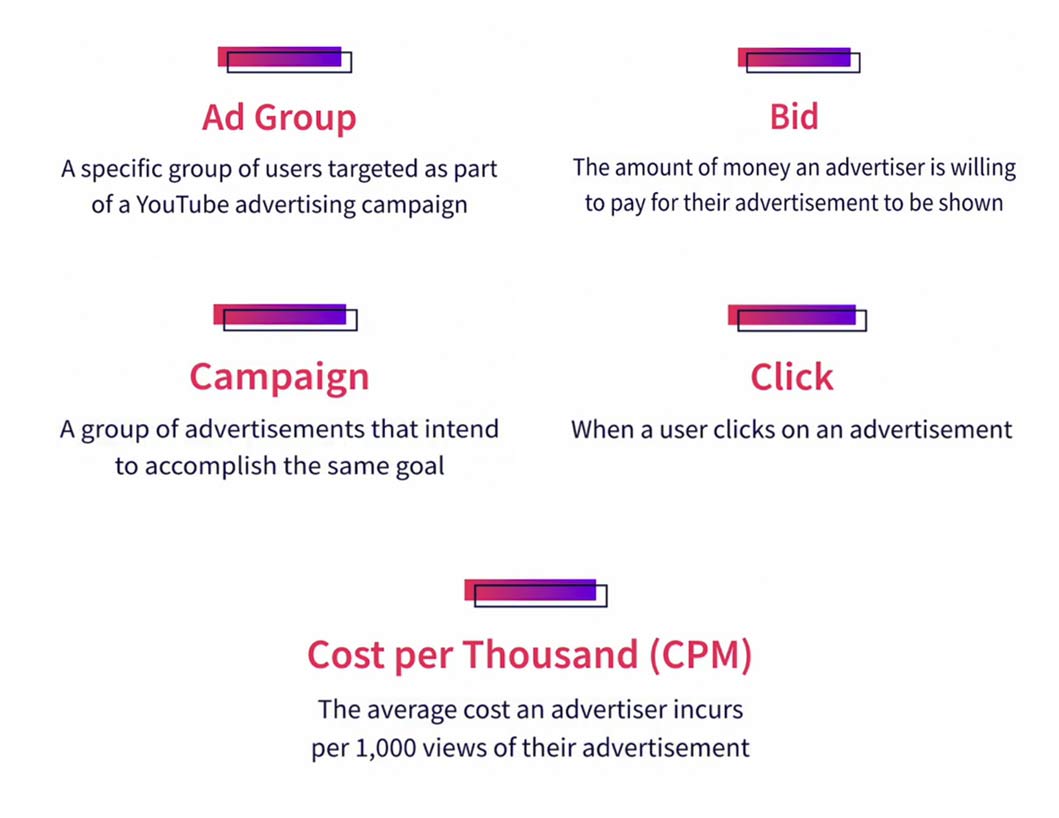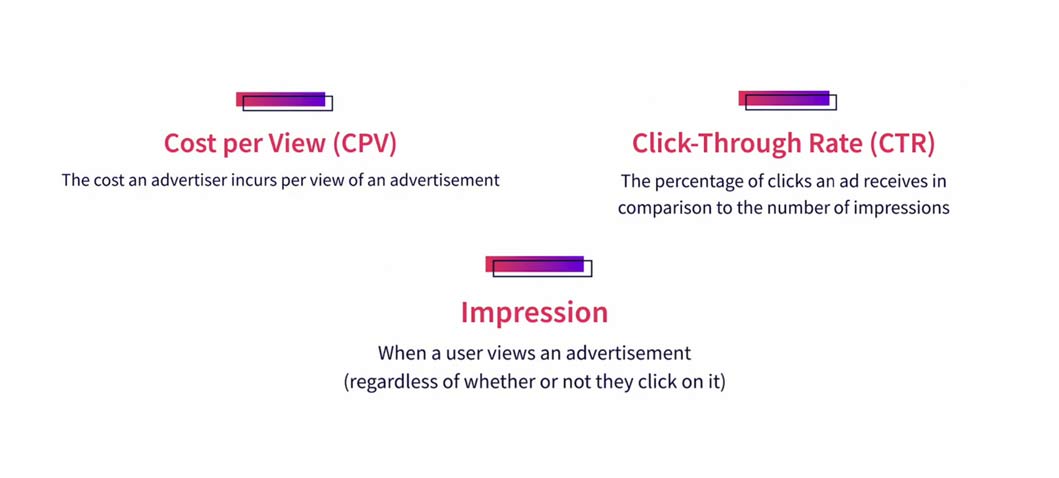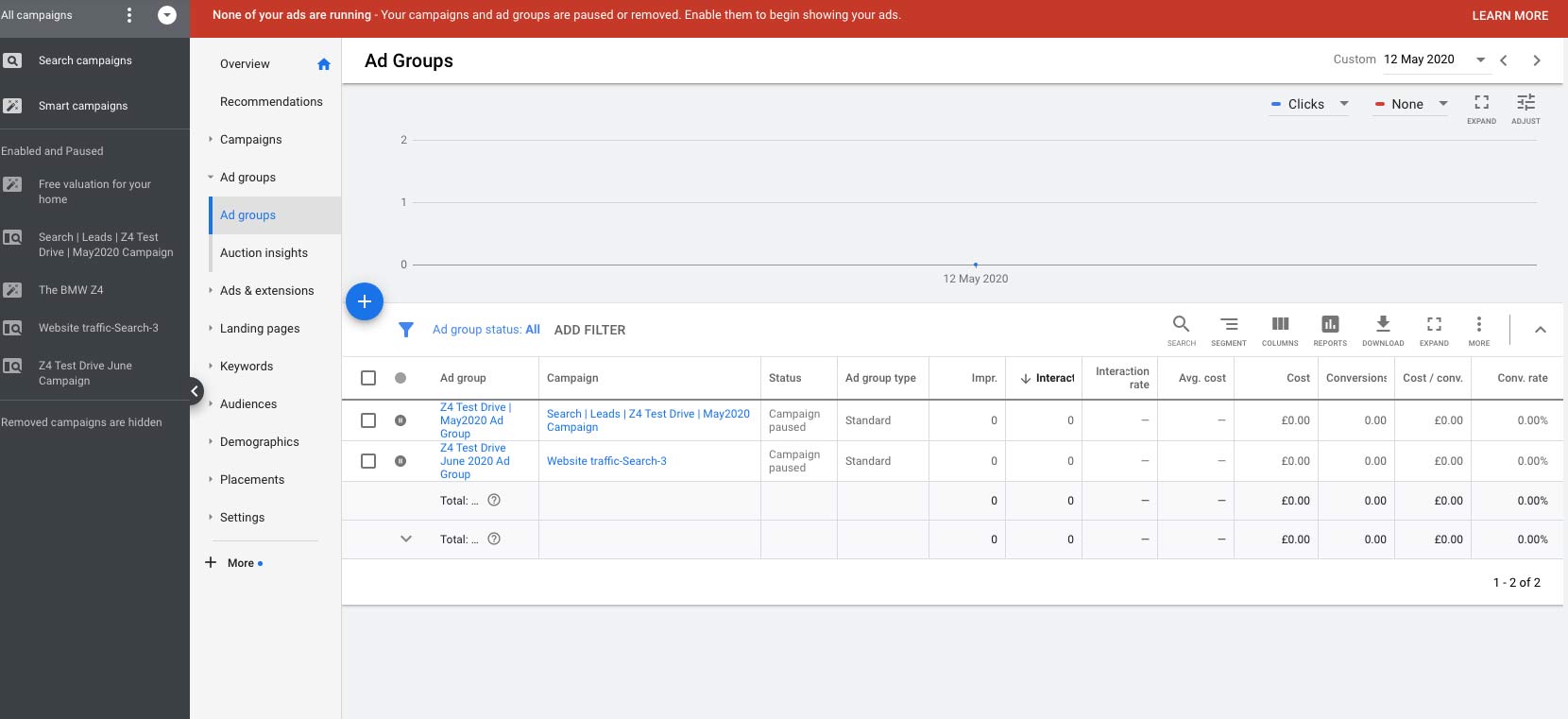Advertising on YouTube
Learn advertising terms and concepts

Learn advertising terms and concepts
Let's go over some key terms that you're going to see as we create an advertising campaign for YouTube.
An ad group, is a specific group of users targeted as part of a YouTube advertising campaign. We're going to create ad groups and when we create an ad group we have the opportunity to specify the demographics of the particular users that we'd like to reach. So we can specify that we'd like our ad to be shown to users of a certain age, a certain gender, income level, and then even users that have special interests. So ad groups are very important to making sure that our message gets in front of the right audience. A bid is the amount of money an advertiser is willing to pay for their advertisement to be shown in front of a video on YouTube. So when we create our advertising campaign, we're going to determine what our maximum daily budget is, and we're going to specify how much we're willing to pay per view of our advertisement based on those settings when somebody's watching a video on YouTube that needs an advertisement, Google is automatically going to go pull in all of those advertisers that are a good fit for that video, and they're going to create a little bidding war between those advertisers. The advertiser that's willing to pay the most has their ad shown in front of the video. So we're not actually going to be bidding ourselves, but the settings that we specify in our campaign are going to determine how much we're willing to bid on each video. A campaign is a group of advertisements that intend to accomplish a similar goal. So we might have one campaign with 10 different videos that are all part of that same campaign. What those 10 videos would have in common is that they're trying to accomplish the same goal, whether it be brand awareness, maybe to sell a product or service, or maybe just to get users to click through to a website. So again, we're going to go over the hierarchy of campaigns and advertisements later on, but it's important to know that a campaign is at the top level. The only thing that the ads within a campaign will have in common is that end goal, like I said, maybe brand awareness, sales, website visits. And then you can target different groups of people from within that one campaign. A click is probably the most self-explanatory of these terms that I'm showing you. But it's important because at the end of the day the whole idea of what we're trying to do by advertising in YouTube is to get clicks. And we take a look at our reports and our analytical data later on in the course, we'll see clicks as part of those analytics. So even though it might be self-explanatory, it's definitely a very important term for advertising on YouTube. Cost per thousand, or CPM, is the average cost that an advertiser incurs per 1,000 views of their advertisement. Now in traditional internet marketing, and what I mean by that is basically when you're advertising banner ads, static advertisements on websites, you generally pay by CPM. As an advertiser you say, okay I want my advertisement to be displayed on your website, and I'll pay you $5 for every thousand views that it gets. On YouTube, we're not going to pay by CPM, we're going to pay per view. However, when we look at our analytical data, we're going to see the metric CPM, which is basically telling us what costs we're incurring for every thousand views of our advertisement. So even though we're not paying based on CPM, it's still an important term and metric because we're going to use that in our analytical data. Cost per view, or CPV, is the cost that an advertiser incurs per view of an advertisement. And this is how we're going to pay for our advertisements on YouTube. We're going to specify what the maximum CPV that we're willing to pay is, and as I mentioned earlier, Google is going to automatically create a bidding war between us and other advertisers, and the advertiser with the highest bid wins. So definitely become familiar with this term CPV, because it's how we're going to pay for our advertisements on YouTube. Click-through rate, or CTR, is the percentage of clicks that an ad receives in comparison to the number of impressions it receives. So just because our ad is being shown to users it doesn't mean that they're actually clicking on it. To make things simple, let's just say that our ad was shown 10 times and it received one click. That means that our click-through rate would be 10%. 10% of the time that our ad is viewed it's clicked on. Now this metric is very important because what it really tells us is the quality of the ad and how engaging the ad is. You can run two different ads to the same group of people, targeting the same keywords, but just have the actual creative, or the video be a little bit different, and then you can take a look at this click-through rate and you can see if one of those ads has a much higher click-through rate than the other one. It basically tells you that that ad is more engaging than the other one. So looking at the click-through rate is a very important indicator of the quality and engagement level of the ads that you're showing on YouTube. Finally, an impression is when a user views an advertisement. It isn't necessarily when they click on it, so as I just mentioned, click-through rate is calculated by dividing your clicks by your impressions. And when we look at our analytical data for our YouTube advertising campaign, impressions are going to be an important part of that. So it's definitely a good idea to be familiar with this term.


YouTube Advertising

Social Media Campaign
Facebook Advertising
Google Adwords-YouTube Video
click on title to view
Learn advertising terms and concepts
How advertising works on YouTube
Google Adwords Advertising
Marketing Content
click on title to view
My Music Selection
|
|
|||||